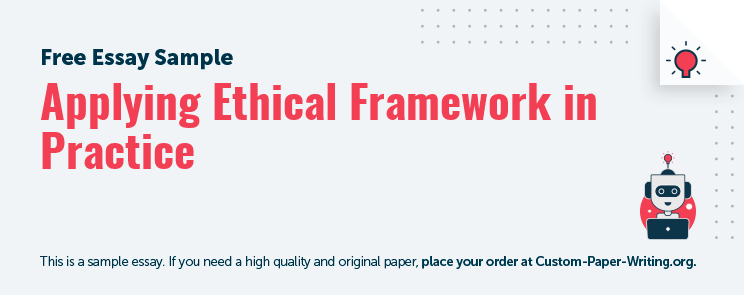
An ethical dilemma is a situation that places a person in a precarious position (Purtilo, & Doherty, 2011). It commonly involves more than one correct course of action that cannot be implemented at the same time. In such a situation, the responsible person or the agent has to choose how to act, predicting the different outcomes possible; thus, his decision may be right or wrong, which fails to take other alternative actions (Harris, 2011). Therefore, for the agent to make a satisfactory decision, he must weigh beliefs, morals, personal values, and more so the sense of wrong and right. The decision is attained through application of the most appropriate decision-making model, depending on the prevailing ethical dilemma. This paper focuses on resolving ethical dilemma faced by a physician in a clinical setting while determining the fate of a child’s health.
The case scenario at hand involves a physician who has diagnosed a six years old child with meningitis. The child at this age is considered to be in the minority, hence any decision on the child’s treatment should be based on the decision of the parents or guardian. Therefore, the physician had to seek legal permission and consent from the parent so as to initiate the treatment. Unfortunately, the two parents had divorced and were living in different states. Upon divorce, the mother was awarded a primary custody for the child, though she was not a biological mother. When consulted, both parents wanted a different course of actions to be taken. Since the mother was a Christian Scientist, she greatly opposed the medical treatment for religious reasons. In contrast, the father was willing to seek medical treatment for the child. He further insisted that an independent consultation should be sought from another physician. The parent responses left the healthcare team in a dubious situation. An ethical dilemma occurred, as the health care team had to plan the further actions regarding the child. In this scenario, both the father and the mother have a right to make a decision on their child’s treatment, but their different choices could result in two different outcomes. Consequently, it was the health care team’s responsibility to decide on the most appropriate and ethical decision to follow. To reach the decision that solves the dilemma, the healthcare providers must employ a decision-making model.
Calculate the cost of essay
The decision-making framework that can be applied to help in ethical decision making for this dilemma is the Realm Individual Process Situation Model (RIPS). The model suggests four ethical decision-making steps that assimilate the RIPS dimensions (Swisher, & Hiller, 2010). The first step is to define and recognize the ethical issue. The step entails an analysis of the facts of the scenario and an in-depth examination of Realm, Individual Process, and ethical Situation. With the relevant information and facts, the base for next steps is established, and the issue can be analyzed based on three components: situation, realm, and individual process. Under Next, the ethical situation is classified as a dilemma, temptation, distress or silence. The framework has three distinguished realms of care ethics: societal, institutional or organizational and individual (Swisher, & Hiller, 2010). After the realm consideration, the model evaluates the tools for individual process engaged in moral behavior and ethical situation. The individual process recognizes moral sensitivity, moral judgment, moral motivation and moral courage.
Limited time Offer
with code
Step two is interpreting and reflecting upon the information collected in the first step, which determines further decision making. For instance, the findings related to realm are of significance in creating the plan of actions that would be taken. Moreover, the individual process and the implication of analysis of the situation are often related. The step also reflects on the major stakeholders, the possible unintended and intended consequences, professional resources, relevant ethical principles, duties, laws and obligations.
The third step involves deciding the right thing to do. The step is specifically meant for resolving a situation where there is a choice between two conflicting courses of actions that are deemed to be right. According to Swisher and Hiller, the model uses three approaches to resolve ethical dilemmas, namely rule-based, ends-based and care-based (2010). However, it is important to identify the limitations and weaknesses of ethical theories, regardless of the approach applied.
Benefit from Our Service: Save 25% Along with the first order offer - 15% discount, you save extra 10% since we provide 300 words/page instead of 275 words/page
The final stage in the RIPS model is implementation, evaluation and re-assessment step. In the fourth stage, the course of action chosen is implemented. Even if significant time is devoted to deciding what to do, more time is required to develop a plan for implementation: the expected outcomes of the action are re-assessed and evaluated at this stage. Re-assessment and evaluation help the agent to determine whether the initial assessment of situation and realm was correct or incorrect, and if they require some reforms or not.
The RIPS decision-making model fits best in developing the course of action for the scenario at hand. The ethical issue is first identified and recognized as an ethical dilemma. The scenario offers two possible alternative courses of action that can be taken; both options refer to an important aspect, but it is impossible to meet both the mother’s and the father’s conditions at a time. In this case, the framework falls under the individual realm. This realm implies that the good of the patient must prevail. The two choices are either to seek medical treatment or not. Although the situation is “right versus right”, the choice that focus on the good for the child is seeking medical treatment from the physician. Whenever meningitis is diagnosed, a quick treatment is essential to reduce its harm to the patient. If untreated, the diseases can lead to long-term complications throughout the child’s life or even death.
- Share this post with your friends:

